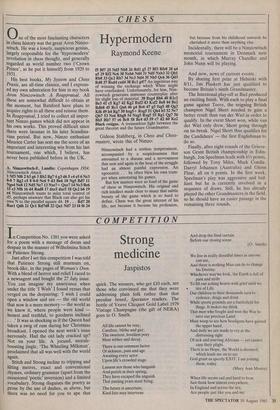CHESS
Hypermodern
Raymond Keene
0 ne of the most fascinating characters in chess history was the great Aron Nimzo- witsch. He was a lonely, suspicious genius,
largely responsible for the 'hypermodern' revolution in chess thought, and generally regarded as world number two (`Crown Prince', as he put it himself) from 1929 to 1931.
His best books, My System and Chess Praxis, are all-time classics, and I express-
ed my own admiration for him in my book
Aron Nimzowitsch: A Reappraisal. All these are somewhat difficult to obtain at the moment, but Batsford have plans to acquire rights to all these and reissue them. In Reappraisal, I tried to collect all impor-
tant Nimzo games which did not appear in his own works. This proved difficult since there were lacunae in his later Scandina- vian period. But now, Nimzo enthusiast Maurice Carter has sent me the score of an important and interesting win from his last tournament, one which, I believe, has never been published before in the UK.
A. Nimzowitsch-E. Lundin: Copenhagen 1934; Nimzowitsch Attack.
1 Nf3 Nf6 2 b3 g6 3 Bb2 Bg7 4 g3 d6 5 c4 e5 6 Nc3 0-0 7 Bg2 c5 8 0-0 Ne6 9 d3 Be6 10 Ng5 Bd7 11 Nge4 Ne8 12 Nd5 Ne7 13 Nxe7+ Qxe7 14 Nc3 Be6 15 e3 Nf6 16 d4 Rad8 17 dxc5 dxc5 18 Qc2 b6 19 e4 Nimzowitsch wants to seize total control of d5, perhaps unaware that Black can also get his own N to the parallel square d4. 19 . . . Rd7 20 Rael Qd6 21 Qcl Rd7d8 22 Qa1 Nd7 23 f4 f6 24 f5 Bf7 25 Nd5 Nb8 26 Rdl g5 27 Bf3 RfeS 28 a4 a5 29 Rf2 Nc6 30 Nxb6 Nd4 31 Nd5 Nxb3 32 Qbl Rb8 33 Qc2 Rb7 34 Nc3 Nd4 35 Nb5 Qc6 36 Qd3 Rd8 37 Bxd4 cxd4 38 Rcl g4!? An ingenious way of winning the exchange which White might have overlooked. Unfortunately, for him, Nim- zowitsch generates immense counterplay after his slight loss of material. 39 Bxg4 Bh6 40 R1c2 Be3 41 c5 Kg7 42 Kg2 Bxf2 43 Kxf2 Be8 44 Be2 Rdb8 45 Rcl Qa6 46 g4 Bc6 47 g5 fxg5 48 Qg3 Kf6 49 h4 Rg7 50 hxg5+ RxgS 51 Qh4 h5 52 Nc7 Qb7 53 Ne6 Rbg8 54 NxgS RxgS 55 Rgl Qg7 56 Bb5 Bbl 57 c6 Bc8 58 Bc4 d3 59 c7 d2 60 Ke2 Black resigns. A tremendous fight between the great theorist and the future Grandmaster.
Gideon Stahlberg, in Chess and Chess- masters, wrote this of Nimzo:
Nimzowitsch had a restless temperament, accompanied by a suspiciousness that amounted to a disease and a nervousness that now and again in the heat of the struggle had an almost painful expression. An egocentric . . . he often blew his own trum- pet when annotating his games. But few masters were so fond of the game of chess as Nimzowitsch. His original and rich intellect made clear to many that subtle beauty of the game which is so hard to define. Chess was the great interest of his life, not because it became his profession, but because from his childhood onwards he cherished it more than anything else. Incidentally, there will be a Nimzowitsch memorial tournament in Denmark next month, in which Murray Chandler and John Nunn will be playing.
And now, news of current events.
By sharing first prize at Helsinki with 8/11, Jim Plaskett has just qualified to become Britain's ninth Grandmaster.
The Interzonal play-off at Biel produced an exciting finish. With each to play a final game against Torre, the reigning British champion Nigel Short needed to gain a better result than van der Wiel in order to qualify. In the event Short won, while van der Wiel only drew, Short going through on tie-break. Nigel Short thus qualifies for the Candidates' — the first Englishman to do so.
Finally, after eight rounds of the Grieve- son Grant British championship in Edin- burgh, Jon Speelman leads with 61/2 points, followed by Tony Miles, Mark Condie, Darryl Johansen (Australia) and Glenn Flear, all on 6 points. In the first week, Speelman's play was aggressive and bril- liant but he is currently involved in a sequence of draws. Still, he has already played the other Grandmasters in the field, so he should have an easier passage in the remaining three rounds.










































 Previous page
Previous page